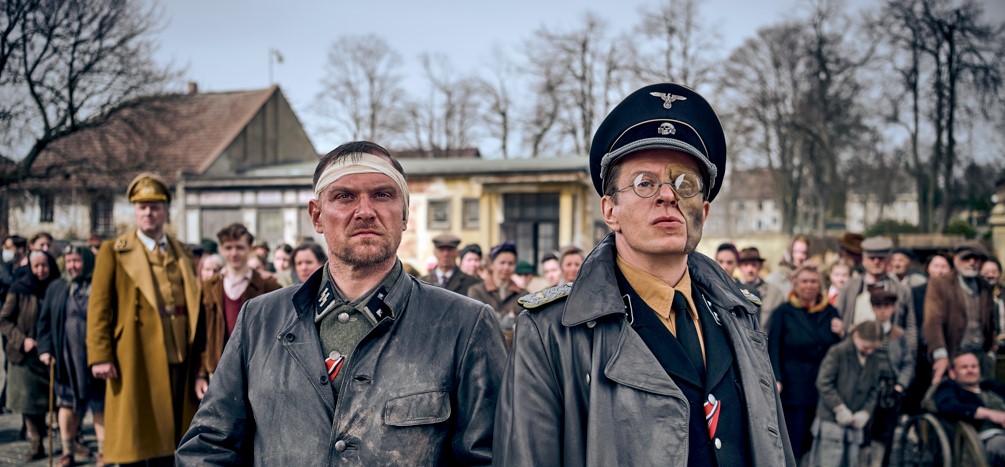Directed by Peter Thorwarth and based on a script by Stefan Barth, ‘Blood and Gold’ is a German action drama film. Set in the spring of 1945, the plot revolves around the German soldier, Private Heinrich (Robert Maaser), who becomes disillusioned about his country’s war efforts and recognizes the horror the Nazis have inflicted upon the Jewish population of Europe. As the war enters its last phase, he deserts the German military and makes his way to Hagen, where the only living member of his family, a daughter named Lottchen, lives with the neighbors. Heinrich lost his pregnant wife and son in a bombing and refuses to lose his daughter.
However, as the film begins, we find him running away from a squad of SS operatives who have come to a small town called Sonnenberg, searching for a cache of gold belonging to a Jewish family. Their leader, von Starnfeld (Alexander Scheer), is a lieutenant colonel who is still very much a fanatic believer in Nazi ideology. SPOILERS AHEAD.
Lieutenant Colonel von Starnfeld is a Fictional Character
No, Lieutenant Colonel von Starnfeld is not based on a real SS officer. The filmmakers have succeeded in keeping their story grounded in reality. Told from the German perspective, the film depicts how indoctrinated small places like Sonnenberg became and the German population turned against their Jewish neighbors. However, for many, this indoctrination ultimately didn’t triumph over opportunism. As they realize that their country is losing the war, the Mayor of Sonnenberg and people like him suddenly become anti-government, eagerly waiting for the Allies to come and “rescue” them.

It is established that von Starnfeld is not one of these people. While his subordinates realize that Germany is losing the war, his belief in his superiors is unshakable to the point of delusion. Although there were people like him in the SS and German military who held onto their beliefs to the bitter end, von Starnfeld is ultimately a fictional character.
Thorwarth called his film “a spaghetti western in the classic sense,” and not necessarily a war film. In an interview with TV Movie, the filmmaker explained that ‘Blood and Gold’ is a homage to the type of films he, Barth, and producer Christian Becker saw when they were young. “There’s a certain responsibility in that, of course, but I didn’t see it as a burden,” he stated. “I make all my films the way I think is right. That might sound a bit lofty, but when I’m on the set I can’t presume what might please whom and why. I have to rely on my intuition. Only when I’m 100 percent convinced of something can I project my genuine enthusiasm onto the team and ultimately onto the screen or screen.”
The Mystery of von Starnfeld’s Mask
After he is hanged and left to die a slow death by von Starnfeld and his men, Heinrich is rescued by a local young woman named Elsa (Marie Hacke), who takes him to her remote farm. Heinrich later returns the favor when the SS officers come to the farm looking for provisions and attempt to rape Elsa. Von Starnfeld kills Elsa’s brother, Paule (Simon Rupp), who appears to have some form of learning disability. Elsa is captured and brought to Von Starnfeld, who compares her to his dead Jewish girlfriend, Rebecca. He reveals that he shot her as he didn’t want her to be sent to a concentration camp.
As he relates the story, Von Starnfeld removes his life-like mask covering half his face, revealing injuries underneath. One of his eyes is missing, as is part of the cheek from that side. These injuries were most likely sustained during the war. The mask he wears is a type of facial prosthetic that became widespread after World War I (though they have existed for centuries, being used to hide injuries and scars related to syphilis. With the remarkable progress in military and medical technology, soldiers began to sustain unprecedented injuries and survive. Plastic surgery was not a common field of study, so these prosthetics, created by professional artists from various materials, became a norm among disfigured soldiers in Europe and North America.
Read More: Blood & Gold Ending, Explained: What Happens To Löwenstein’s Gold?


You must be logged in to post a comment.